Frequency Analysis of Vibrations in Terms of Human Exposure While Driving Military Armoured Personnel Carriers and Logistic Transportation Vehicles
Abstract
1. Introduction
2. Evaluation Techniques of Vibration Exposure
3. Experimental Research
3.1. Experimental Testbed
- -
- One uniaxial accelerometer was mounted on the cylinder cover and one accelerometer on the chassis, as can be observed in Figure 6. Both were used for measurements along the vertical axis.
- -
- One triaxial accelerometer type SV105 for hand-arm measurements was attached to the driver’s hand and one triaxial accelerometer SV100A was used for seat measurements. The data were recorded by a vibration analyser type SV106A SVANTEK, as shown in Figure 7.
3.2. Instrumentation
- ADASH A4400 VA4 Pro data acquisition system;
- Single-axis accelerometer type 160.01;
- Vibration analyser type SV106A SVANTEK;
- Triaxial accelerometers type SV100A and SV105;
4. Results of Experimental Research
4.1. Vibrations Transmitted to the Driver
- Green—values are within the limits imposed by Directive 2002/44/EC [16];
- Red—values above the upper limit.
4.1.1. Values Measured in Case of the Vehicle Destined for Cargo Transportation
- →
- , , —average values of frequency-weighted acceleration, in the case of the hand-arm system, along the x, y, z axes.
- -
- , , —average values of frequency-weighted acceleration in the case of the whole-body system, along the x, y, z axes;
- -
- VDV (x), VDV (y), VDV (z)—vibration dose values, along the x, y, z axes.
4.1.2. Values Measured in Case of the Vehicle Destined for Troops Transportation
4.2. Interpretation of Results
5. Conclusions
Author Contributions
Funding
Institutional Review Board Statement
Informed Consent Statement
Data Availability Statement
Conflicts of Interest
References
- Yamakawa, S. Vibration Data Analysis of Automobiles. In The Practice of Time Series Analysis. Statistics for Engineering and Physical Science; Akaike, H., Kitagawa, G., Eds.; Springer: New York, NY, USA, 1999. [Google Scholar] [CrossRef]
- Griffiths, K.R.; Hicks, B.J.; Keogh, P.S.; Shires, D. Wavelet analysis to decompose a vibration simulation signal to improve pre-distribution testing of packaging. Mech. Syst. Signal Process. 2016, 76–77, 780–795. [Google Scholar] [CrossRef]
- Hoz-Torres, M.L.; Aguilar, A.J.; Ruiz, D.P.; Martinez-Aires, M.D. Whole Body Vibration Exposure Transmitted to Drivers of Heavy Equipment Vehicles: A Comparative Case According to the Short- and Long-Term Exposure Assessment Methodologies Defined in ISO 2631-1 and ISO 2631-5. Int. J. Environ. Res. Public Health 2022, 19, 5206. [Google Scholar] [CrossRef] [PubMed]
- Park, D.J.; Choi, M.G.; Song, J.T.; Ahn, S.J.; Jeong, W.B. Attention decrease of drivers exposed to vibration from military vehicles when driving in terrain conditions. Int. J. Ind. Ergon. 2019, 72, 363–371. [Google Scholar] [CrossRef]
- Paddan, G.S.; Mcllraith, M.L.L. Noise and vibration measurements in a Viking military vehicle. Def. Technol. 2021, 17, 1976–1987. [Google Scholar] [CrossRef]
- STO Technical Report. Evaluation of In-Vehicle Vibrations and Their Effect on Vehicle Structures and Personnel Health and Performance, NATO Science and Technology Organization/AVT Support Project No. SVK-AVT-16/01. Final Report, January 2020, ISBN 978-92-837-2229-8. Available online: https://apps.dtic.mil/sti/citations/trecms/AD1183723 (accessed on 4 April 2023).
- Seidel, H. On the Relationship between Whole-body Vibration Exposure and Spinal Health Risk. Ind. Health 2005, 43, 361–377. [Google Scholar] [CrossRef] [PubMed]
- Wrobel, T.; Szudrowicz, M.; Luty, W.; Senko, J. Military special vehicle multifunctional seat as an element of vehicle passive safety. In Proceedings of the 13th International Conference on Automotive Safety (Automotive Safety 2022), IOP Conference Series: Materials Science and Engineering, Kaluza, Slovakia, 26–29 April 2022. [Google Scholar] [CrossRef]
- Voicu, D.; Stoica, R.M.; Barothi, L.; Vilau, R. Influence analysis of vibrations and shocks generated by road bumps on crew members during long distance transportation or on off-road terrain. Ing. Automob. Automob. Eng. 2022, 63, 15–18. [Google Scholar]
- ISO 2631; Mechanical Vibration and Shock—Evaluation of Human Exposure to Whole Body Vibration. 1997–2004. Available online: https://www.iso.org/obp/ui/#search (accessed on 4 April 2023).
- ISO 5349-2:2001; Mechanical Vibration—Measurement and Evaluation of Human Exposure to Hand-Transmitted Vibration—Part 2: Practical Guidance for Measurement at the Workplace. ISO: Geneva, Switzerland, 2001.
- Nawayseh, N.; Griffin, M.J. Non-linear dual-axis biodynamic response to fore-and-aft whole-body vibration. J. Sound Vib. 2005, 282, 831–862. [Google Scholar] [CrossRef]
- Nawayseh, N.; Griffin, M.J. Non-linear dual-axis biodynamic response to vertical whole-body vibration. J. Sound Vib. 2003, 268, 503–523. [Google Scholar] [CrossRef]
- Wilkström, B.O.; Kjellberg, A.; Landstrom, U. Health effects of long-term occupational exposure to whole-body vibration: A review. Int. J. Ind. Ergon. 1994, 14, 273–292. [Google Scholar] [CrossRef]
- Howarth, H.V.C.; Griffin, M.J. Subjective reaction to vertical mechanical shocks of various waveforms. J. Sound Vib. 1991, 147, 395–408. [Google Scholar] [CrossRef]
- Directiva 2002/44/CE a Parlamentului European și a Consiliului din 25 iunie 2002, Privind Cerințele Minime de Securitate și Sănătate Referitoare la Expunerea Lucrătorilor la Riscurile Generate de agenți Fizici (Vibrații)—In English: Directive 2002/44/CE of European Parliament and Council from June 25, 2002, Regarding Minimum Health and Safety Requirements Concerning the Exposure of Workers to the Risks Generated by Physical Agents (Vibrations)]. Available online: https://eur-lex.europa.eu/LexUriServ/LexUriServ.do?uri=CONSLEG:2002L0044:20081211:RO:PDF (accessed on 4 April 2023).
- Adam, S.A.; Jalil, N.A.A. Vertical suspension seat transmissibility and seat values for seated persons exposed to whole-body vibration in agricultural tractor preliminary study. Procedia Eng. 2017, 170, 435–442. [Google Scholar] [CrossRef]
- Available online: https://www.haspod.com/blog/vibration/how-to-calculate-vibration-exposure-elv (accessed on 4 April 2023).
- Ahmad, E.; Youn, I. Performance Improvement during Attitude Motion of a Vehicle Using Aerodynamic-Surface-Based Anti-Jerk Predictive Controller. Sensors 2023, 23, 5714. [Google Scholar] [CrossRef] [PubMed]
- Grami, S.; Nawayseh, N.; Hamdan, S. Effect of car speed on the transmission of vibration through the seat pan and backrest: Field study. Int. J. Veh. Noise Vib. 2020, 15, 192–204. [Google Scholar] [CrossRef]
- Paschold, H.W.; Mayton, A.G. WholeBody Vibration, Professional Safety. Available online: https://www.researchgate.net/publication/268214389_Paschold_HW_and_AG_Mayton_2011_Whole-body_Vibration_Professional_Safety_-_Journal_of_the_American_Society_of_Safety_Engineers_56_4_30-35 (accessed on 4 April 2023).
- Maeda, S.; Ye, Y.; Gao, S. Necessity and considerations for on-body vibration measurement equipment. Proceedings 2023, 86, 3. [Google Scholar] [CrossRef]
- Bendat, S. Random Data Analysis and Measurement Procedures; John Wiley & Sons: New York, NY, USA, 2010. [Google Scholar] [CrossRef]
- Brigham, E. Fast Fourier Transform and its Applications; Prentice Hall Press: Hoboken, NJ, USA, 1988. [Google Scholar]
- Khaksar, Z.; Ahmadi, H.; Mohtasebi, S.S. Whole body vibration analysis of tractor operators using power spectral density. J. Mech. Eng. Technol. 2013, 1, 6–12. [Google Scholar] [CrossRef]
- Irvine, T. Power Spectral Density Units: [G2/Hz]; Vibration Data Press: 2007. Available online: https://vibrationdata.com/tutorials2/psd.pdf. (accessed on 19 July 2023).
- Digulescu, A.; Paun, M.; Vasile, C.; Petrut, T.; Deacu, D.; Ioana, C.; Tamas, R. Electrical arc surveillance and localization system based on advanced signal processing techniques. In Proceedings of the 2014 IEEE International Energy Conference (ENERGYCON), Cavtat, Croatia, 13–16 May 2014; pp. 426–430. [Google Scholar]
- Digulescu, A.; Murgan, I.; Ioana, C.; Candel, I.; Serbanescu, A. Applications of Transient Signal Analysis Using the Concept of Recurrence Plot Analysis. Recurr. Plots Their Quantif. Expand. Horiz. 2016, 180, 19–38. [Google Scholar]
- Digulescu, A.; Murgan, I.; Candel, I.; Bunea, F.; Ciocan, G.; Bucur, D. Cavitating vortex characterization based on acoustic signal detection. In Proceedings of the 28th IAHR symposium on Hydraulic Machinery and Systems, Grenoble, France, 4–8 July 2016; pp. 1–10. [Google Scholar]
- Ioana, C.; Digulescu, A.; Serbanescu, A.; Candel, I.; Birleanu, F. Recent advances in non-stationary signal processing based on Recurrence Plot Analysis concept. In Translational Recurrences. From Mathematical Theory to Real-World Applications; Marwan, N., Riley, M., Giuliani, A., Webber, C., Jr., Eds.; Springer Proceedings in Mathematics & Statistics; Springer: Berlin/Heidelberg, Germany, 2014; Volume 103, pp. 75–93. [Google Scholar]
- Burdzik, R. Impact and Assessment of Suspension Stiffness on Vibration Propagation into Vehicle. Sensors 2023, 23, 1930. [Google Scholar] [CrossRef] [PubMed]
- Available online: https://ro.wikipedia.org/wiki/TABC-79 (accessed on 4 April 2023).
- Available online: https://adash.com (accessed on 4 April 2023).
- ISO 8041-1:2017; Human Response to Vibration—Measuring Instrumentation—Part 1: General Purpose Vibration Meters, Technical Committee: ISO/TC108 Mechanical Vibration, Shock and Condition Monitoring. ISO: Geneva, Switzerland, 2017. Available online: https://www.iso.org/standard/70648.html (accessed on 4 April 2023).
- Available online: https://svantek.com/ (accessed on 4 July 2023).
- Faisal, A.I.; Majumder, S.; Mondal, T.; Cowan, D.; Naseh, S.; Deen, M.J. Monitoring Methods of Human Body Joints: State-of-the-Art and Research Challenges. Sensors 2019, 19, 2629. [Google Scholar] [CrossRef] [PubMed]
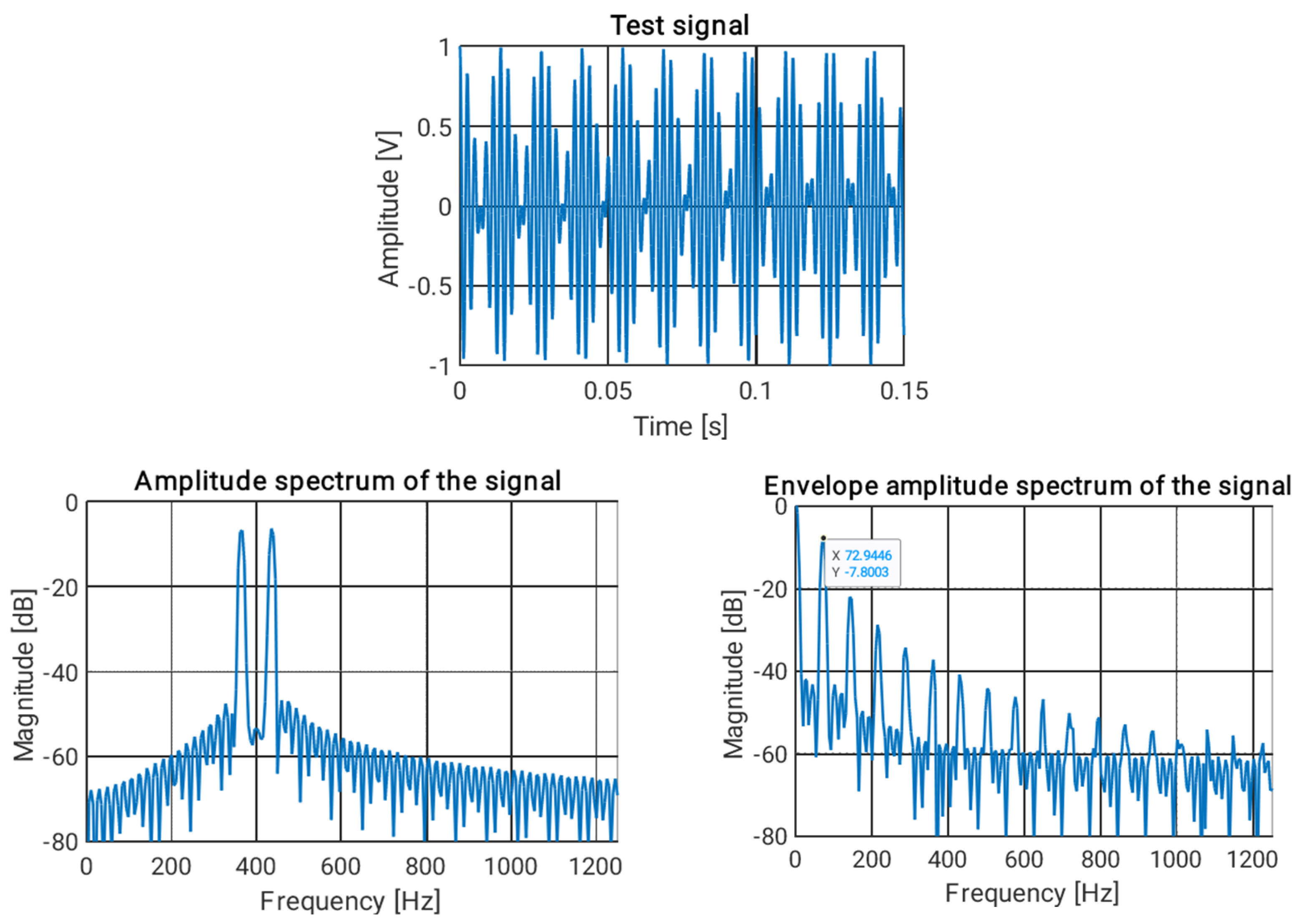
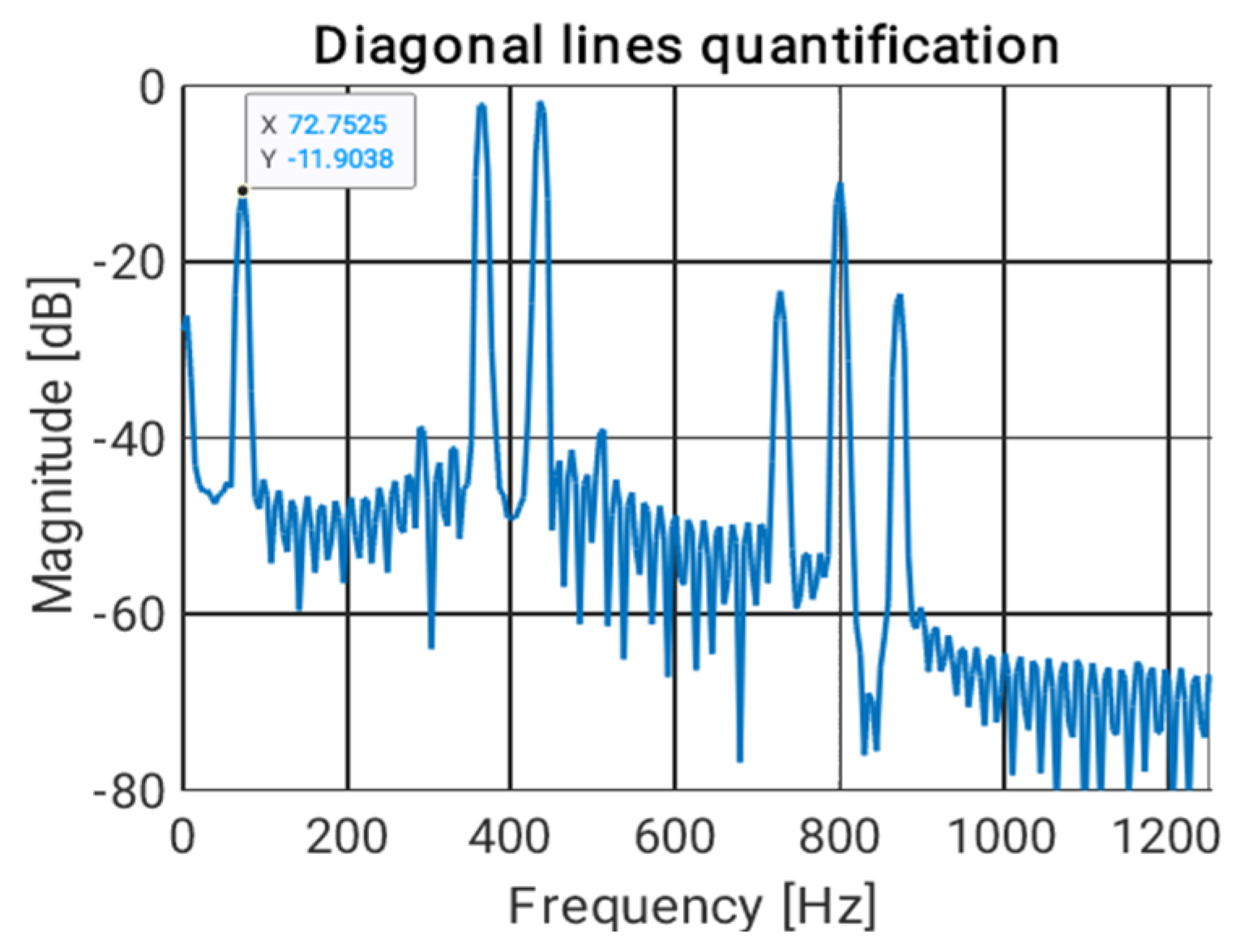

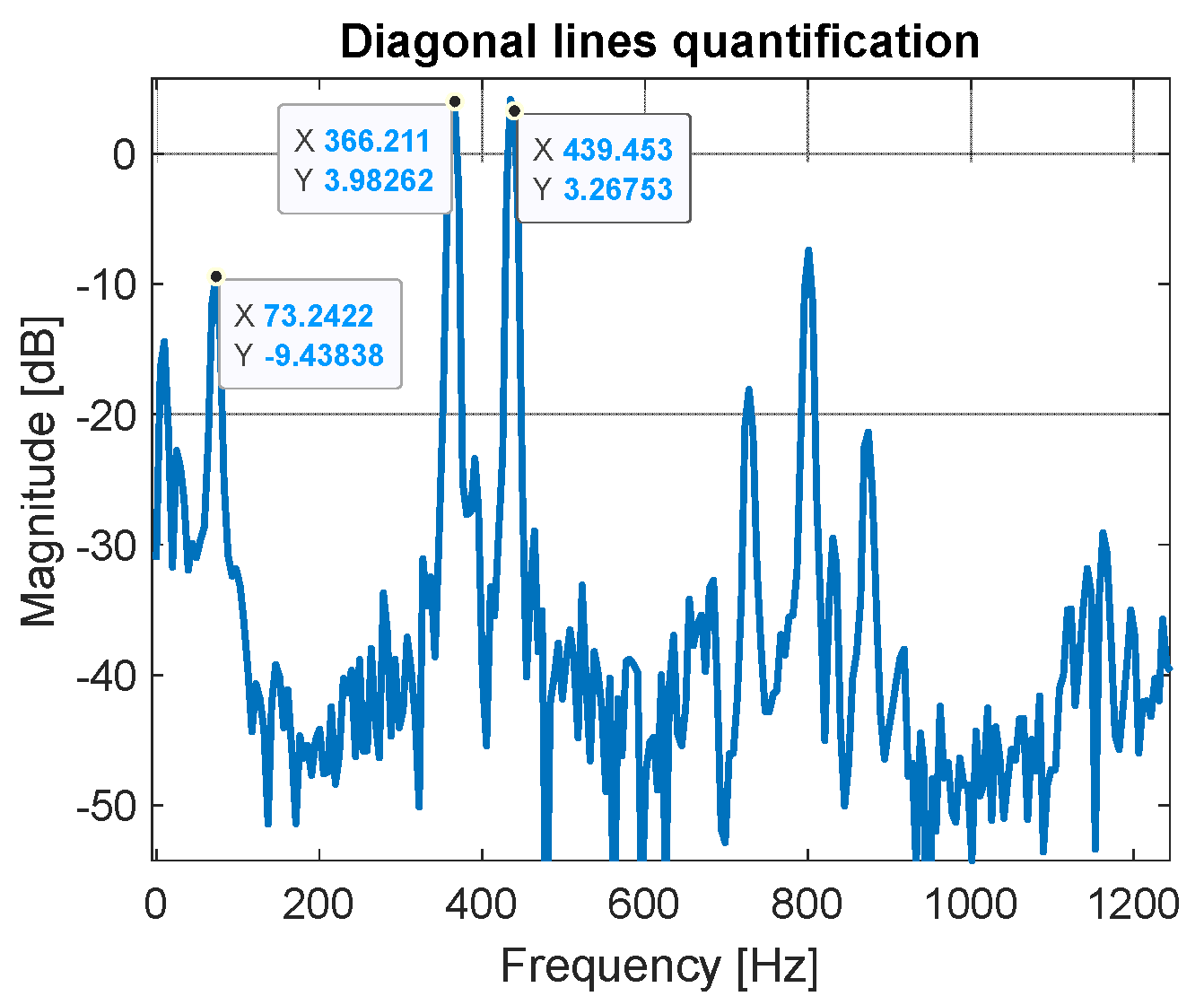



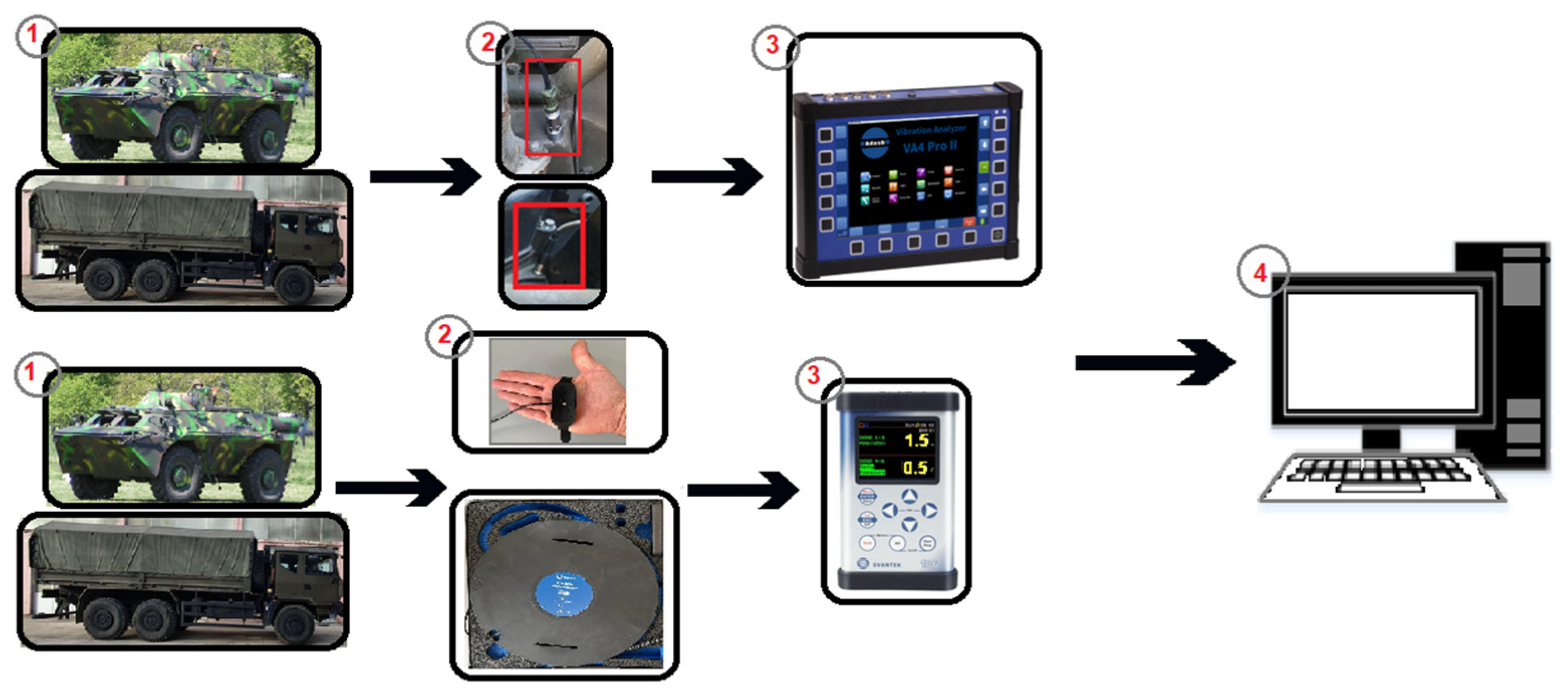
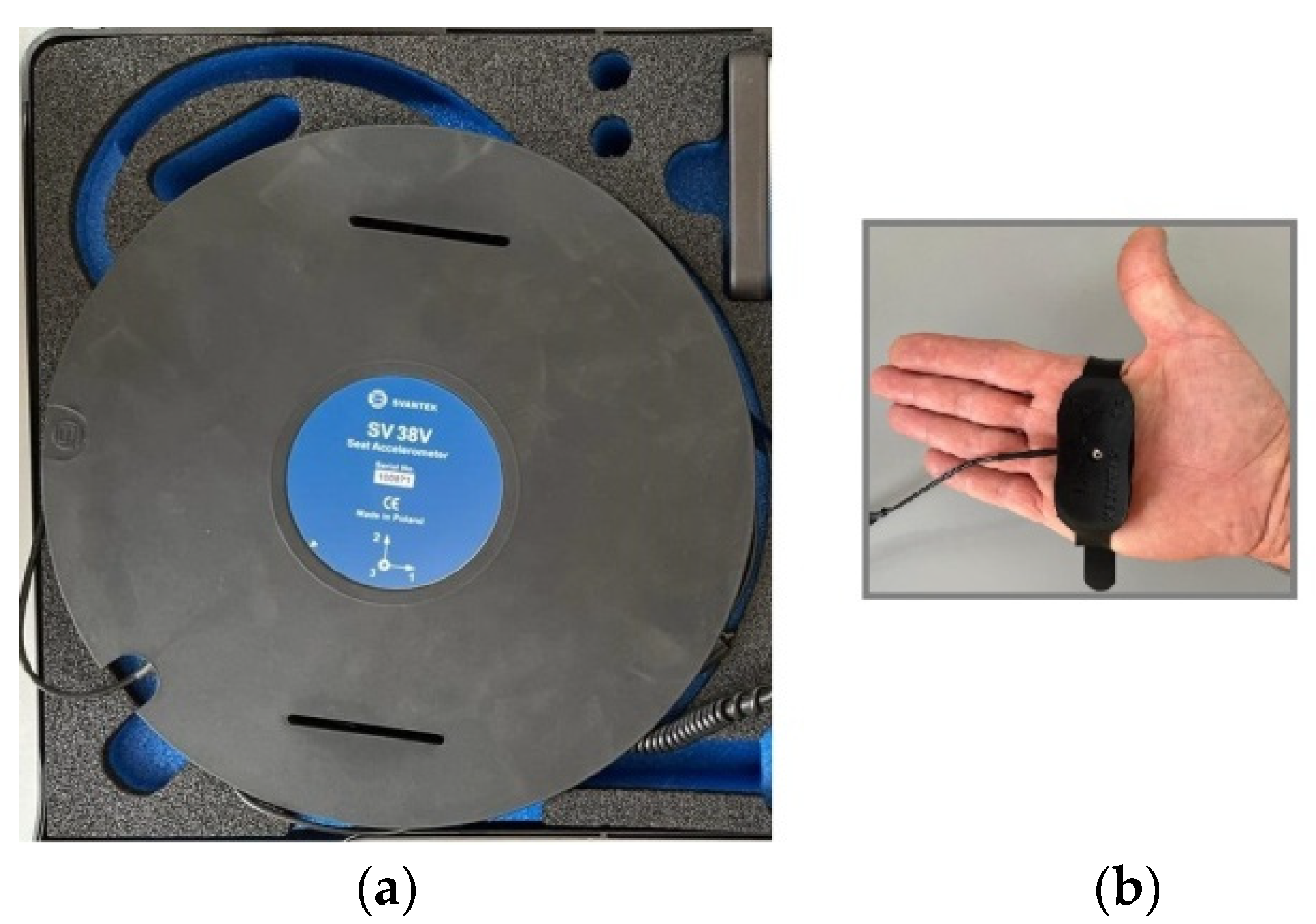
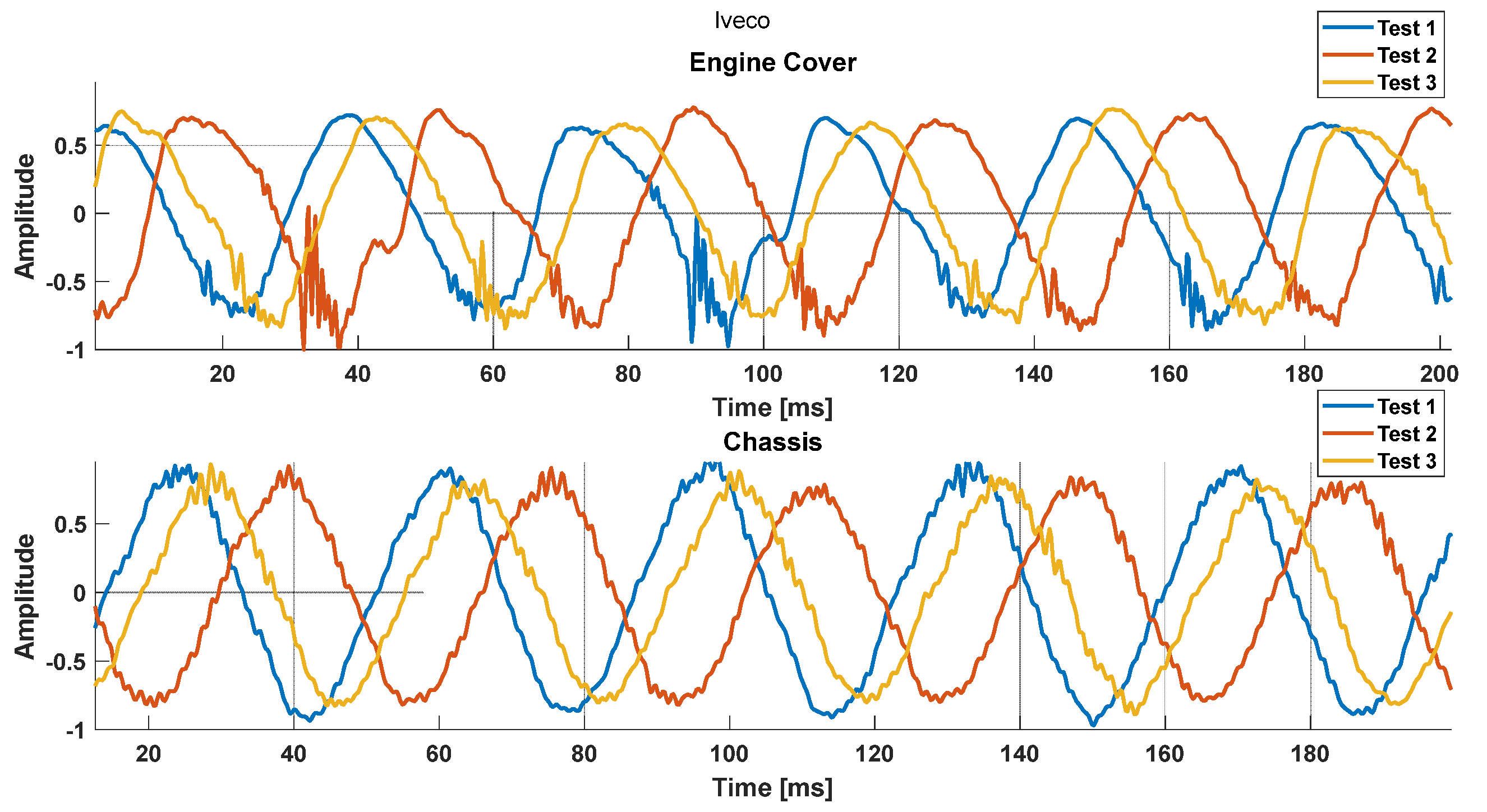




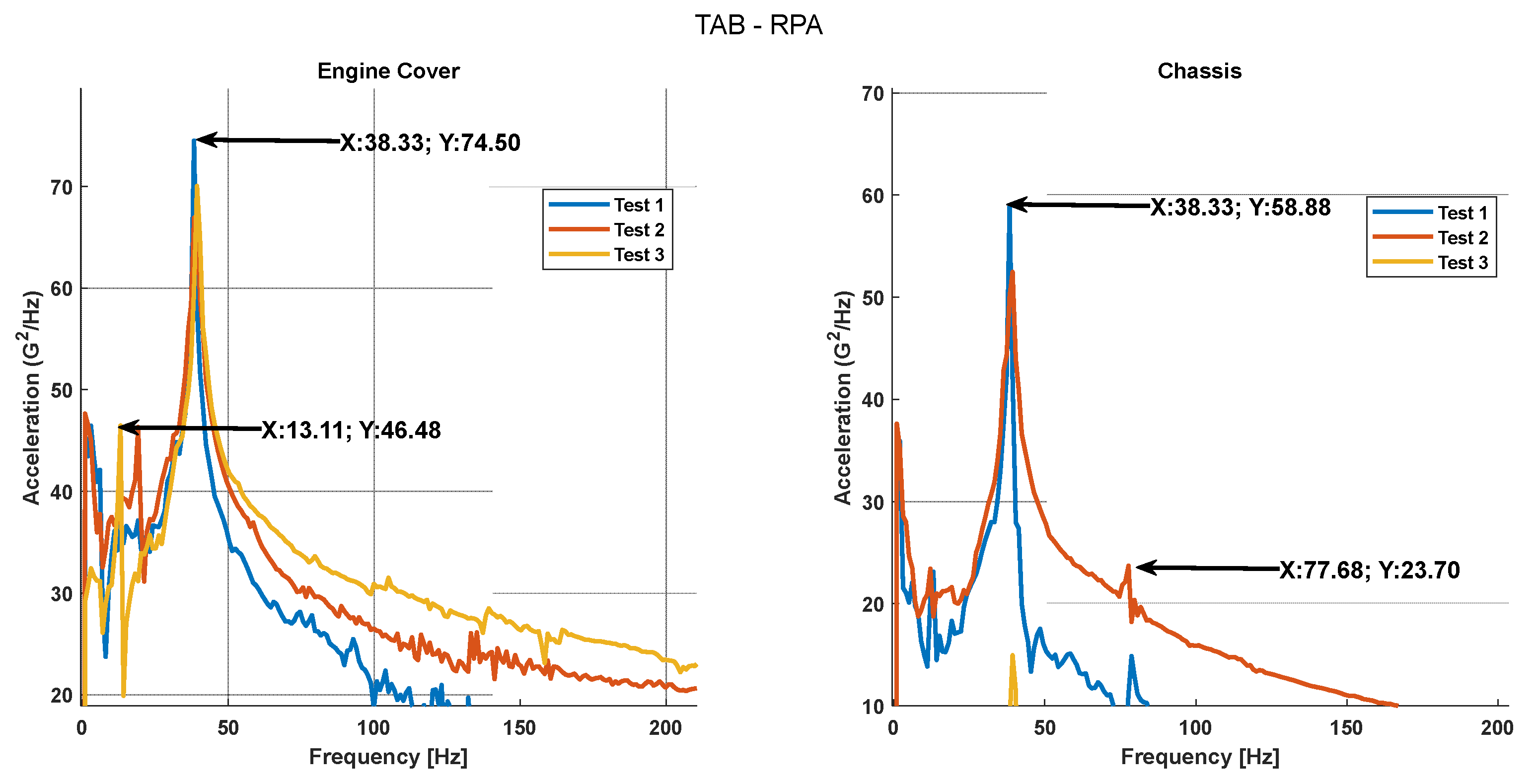
| Symptom | Frequency (Hz) |
|---|---|
| General state of discomfort | 4–9 |
| Headaches | 13–20 |
| Jaw pain | 6–8 |
| Talking deficiency | 13–20 |
| Heavy breathing | 12–16 |
| Chest pain | 5–7 |
| Stomach pain | 4–10 |
| Eyeball pain | 60–90 |
| Jaw line pain | 100–200 |
| Test Number | [m/s2] | [m/s2] | [m/s2] | [m/s2] | A(8) [m/s2] Limit Value (According to ISO 5349-2) | Period of Exposure [s] |
|---|---|---|---|---|---|---|
| Test 1 | 2.267 | 1.752 | 2.344 | 3.702 | 5 | 60 |
| Test 2 | 1.542 | 1.462 | 1.262 | 2.471 | 60 | |
| Test 3 | 1.099 | 1.266 | 1.236 | 2.083 | 60 |
| Test Number | [m/s2]/ | [m/s2]/ | [m/s2]/ | [m/s2] | Limit Value [m/s2] According to ISO 2631-1/ | Period of Exposure [s] | |
|---|---|---|---|---|---|---|---|
| VDV (x) | VDV (y) | VDV (z) | Daily Exposure [m/s1.75] | Limit Value [m/s1.75] According to ISO 5349-2 | |||
| Test 1 | A(8) | 0.527 | 0.421 | 0.605 | 0.737 | 1.15 | 60 |
| VDV | 4.310 | 1.837 | 2.526 | 26.802 | 21 | ||
| Test 2 | A(8) | 0.587 | 0.482 | 0.639 | 0.822 | 1.15 | 60 |
| VDV | 4.385 | 1.873 | 2.521 | 28.737 | 21 | ||
| Test 3 | A(8) | 0.561 | 0.496 | 0.655 | 0.785 | 1.15 | 60 |
| VDV | 3.917 | 1.943 | 2.732 | 25.565 | 21 |
| Test Number | [m/s2] | [m/s2] | [m/s2] | [m/s2] | A(8) [m/s2] Limit Value (According to ISO 5349-2) | Period of Exposure [s] |
|---|---|---|---|---|---|---|
| Test 1 | 1.112 | 1.429 | 1.216 | 2.181 | 5 | 120 |
| Test 2 | 1.542 | 1.991 | 1.514 | 2.938 | 120 | |
| Test 3 | 1.015 | 1.377 | 0.927 | 1.946 | 120 |
| Test Number | [m/s2] | [m/s2] | [m/s2] | [m/s2] | Limit Value [m/s2] According to ISO 2631-1/ | Period of Exposure [s] | |
|---|---|---|---|---|---|---|---|
| VDV (x) | VDV (y) | VDV (z) | Daily Exposure [m/s1.75] | Limit Value [m/s1.75] according to ISO 5349-2 | |||
| Test 1 | A(8) | 0.480 | 0.223 | 0.471 | 0.672 | 1.15 | 120 |
| VDV | 2.877 | 1.230 | 3.003 | 14.897 | 21 | ||
| Test 2 | A(8) | 0.392 | 0.215 | 0.413 | 0.548 | 1.15 | 120 |
| VDV | 2.175 | 1.114 | 2.241 | 11.817 | 21 | ||
| Test 3 | A(8) | 0.559 | 0.221 | 0.585 | 0.783 | 1.15 | 120 |
| VDV | 1.961 | 0.679 | 1.886 | 16.159 | 21 |
Disclaimer/Publisher’s Note: The statements, opinions and data contained in all publications are solely those of the individual author(s) and contributor(s) and not of MDPI and/or the editor(s). MDPI and/or the editor(s) disclaim responsibility for any injury to people or property resulting from any ideas, methods, instructions or products referred to in the content. |
© 2023 by the authors. Licensee MDPI, Basel, Switzerland. This article is an open access article distributed under the terms and conditions of the Creative Commons Attribution (CC BY) license (https://creativecommons.org/licenses/by/4.0/).
Share and Cite
Voicu, D.; Stoica, R.M.; Vilău, R.; Marinescu, M.; Digulescu, A.; Despina-Stoian, C.; Popescu, F. Frequency Analysis of Vibrations in Terms of Human Exposure While Driving Military Armoured Personnel Carriers and Logistic Transportation Vehicles. Electronics 2023, 12, 3152. https://doi.org/10.3390/electronics12143152
Voicu D, Stoica RM, Vilău R, Marinescu M, Digulescu A, Despina-Stoian C, Popescu F. Frequency Analysis of Vibrations in Terms of Human Exposure While Driving Military Armoured Personnel Carriers and Logistic Transportation Vehicles. Electronics. 2023; 12(14):3152. https://doi.org/10.3390/electronics12143152
Chicago/Turabian StyleVoicu, Daniela, Ramona Monica Stoica, Radu Vilău, Marin Marinescu, Angela Digulescu, Cristina Despina-Stoian, and Florin Popescu. 2023. "Frequency Analysis of Vibrations in Terms of Human Exposure While Driving Military Armoured Personnel Carriers and Logistic Transportation Vehicles" Electronics 12, no. 14: 3152. https://doi.org/10.3390/electronics12143152
APA StyleVoicu, D., Stoica, R. M., Vilău, R., Marinescu, M., Digulescu, A., Despina-Stoian, C., & Popescu, F. (2023). Frequency Analysis of Vibrations in Terms of Human Exposure While Driving Military Armoured Personnel Carriers and Logistic Transportation Vehicles. Electronics, 12(14), 3152. https://doi.org/10.3390/electronics12143152







